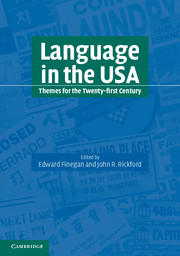Book contents
- Frontmatter
- Contents
- List of figures
- List of tables
- List of contributors
- Acknowledgments
- Foreword
- Editors' preface
- Part 1 American English
- 1 American English: its origins and history
- 2 American English and its distinctiveness
- 3 Regional dialects
- 4 Social varieties of American English
- 5 African American English
- 6 The Dictionary of American Regional English
- Part 2 Other language varieties
- Part 3 The sociolinguistic situation
- Index
4 - Social varieties of American English
Published online by Cambridge University Press: 05 June 2012
- Frontmatter
- Contents
- List of figures
- List of tables
- List of contributors
- Acknowledgments
- Foreword
- Editors' preface
- Part 1 American English
- 1 American English: its origins and history
- 2 American English and its distinctiveness
- 3 Regional dialects
- 4 Social varieties of American English
- 5 African American English
- 6 The Dictionary of American Regional English
- Part 2 Other language varieties
- Part 3 The sociolinguistic situation
- Index
Summary
Editors' introduction
This chapter explores the nature of social dialects within American English – in relation to which the stakes are much higher than they are for regional dialects. Your employability, intelligence, sincerity (even guilt) may be judged solely on the basis of the status-, ethnicity-, age- or gender-based variety you speak. These dimensions can interact with each other as well as with region, so that a linguistic feature that is socially distinctive in one city or ethnic group may not be distinctive in another. Vernacular varieties tend to have negatively valued or stigmatized features (like double negatives), while so-called “standard” varieties are negatively defined as lacking them.
Contrary to popular perception, as Walt Wolfram observes, “group exclusive” usages (e.g., “All women and no men say X”) are rarer than “group preferential” usages (e.g., “Women are more likely than men to say X”), at least in the USA. Thus it is important to use quantitative methods to study socially conditioned linguistic variation, and to follow the accountability principle, which entails reporting the percentages of each variant observed out of the total number of cases in which it could have been used. Using an example involving variation between -ing and -in, in words like walking and swimming, Wolfram shows us how to do the requisite quantitative analysis and how to look for the linguistic and social or psychological factors that constrain linguistic variation. Linguistic variation is almost never haphazard.
- Type
- Chapter
- Information
- Language in the USAThemes for the Twenty-first Century, pp. 58 - 75Publisher: Cambridge University PressPrint publication year: 2004
- 15
- Cited by



